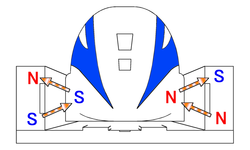
The SCMaglev (superconducting maglev, formerly called the MLU) is a magnetic levitation (maglev) railway system developed by Central Japan Railway Company (JR Central) and the Railway Technical Research Institute. [1] [2] [3]
Contents
- Technology
- History
- Miyazaki test track
- Yamanashi maglev test line
- Commercial use
- Japan
- United States
- Australia
- Vehicles
- Records
- Manned records
- Unmanned records
- Relative passing speed records
- See also
- References
- Further reading
- External links
The SCMaglev uses an electrodynamic suspension (EDS) system for levitation, guidance, and propulsion.
In development since the 1960s, the SCMaglev system will be used in the Chūō Shinkansen rail line between Tokyo and Nagoya, Japan. The line, currently under construction, is scheduled to open in 2034 (after delays pushing back its original opening date of 2027.) JR Central is also seeking to sell or license the technology to foreign rail companies. The L0 Series, a prototype vehicle based on SCMaglev technology, holds the record for fastest crewed rail vehicle with a record speed of 603 km/h (375 mph). [4]













